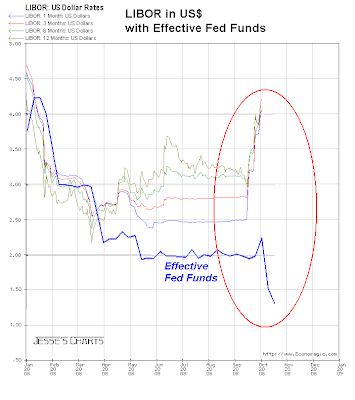My friend Bart at Nowandfutures.com and I have discovered the cause of the discrepancy between his, and presumably John Williams' estimate of Eurodollars for their M3 estimates, and the BIS reports of Eurodollars.
The Fed's estimate seems to be limited to foreign branches of US banks only.
The Board of Governors of the Federal Reserve discontinued the Weekly Report of Eurodollar Liabilities Held by Selected U.S. Addressees at Foreign Offices of U.S. Banks (FR 2050; OMB No. 7100-0068) in March 2006. In November 2005, the Federal Reserve decided to cease collecting, constructing, and publishing the M3 monetary aggregate, effective in March 2006. As a result of the Federal Reserve's decision to cease constructing the M3 monetary aggregate, data collected on the FR 2050 are no longer needed.
This voluntary report collected two items of daily data once a week: (1) total non-negotiable Eurodollars and (2) negotiable term Eurodollars held in custody accounts, both payable to U.S. addressees other than depository institutions and money market mutual funds. The primary use of the data was to construct the Eurodollar component of the M3 monetary aggregate. The data were also used for analysis of depository institutions' funding practices.
This puts a more practical cast on the discontinuance of the M3 report.
As the BIS reports make very clear, the Fed's method was greatly underestimating the amount of dollars held by overseas banks, which is how the marketplace had come to define Eurodollars.
"A dollar-denominated deposit made in foreign banks or foreign branches of U.S. banks. Depositors sometimes transfer their funds to European banks in order to take advantage of higher interest rates. The Eurodollar is one type of Eurocurrency. Eurodollars are US currency deposited in banks outside the United States but not always in Europe. Certain debt securities are issued in eurodollars and pay interest in US dollars into non-US bank accounts. Eurodollars are a form of eurocurrency."
I think the term Eurodollars outgrew its origins, as it had come to refer to all dollars held overseas outside the jurisdiction of the Fed and the US Federal Government. As you may recall, eurodollars started as a movement by certain entities to hold their US dollar assets outside the Fed to avoid the freezing and seizure of their assets, but it become much more broadly used as the dollar grew into the global reserve currency.
The Fed was faced with the choice of incurring the expense of going back and correcting their numbers to reflect the broader definition. And since they have no authority over non-member banks, they would have to rely on BIS to provide them the data. Their decision was to either redefine M3, or simply discontinue it. They chose the latter.
So to avoid confusion, Eurodollars will refer to any US dollar held as foreign currency as defined by the BIS. M3 Eurodollars will refer to the discontinued series by the Fed which estimated the dollars held overseas at branches of US banks.
I would agree with the Fed that their definition was becoming quaintly irrelevant to the markets. I estimate that today the M3 eurodollars represent less than half of Eurodollars held around the world if one includes official reserves as well as reported commercial bank holdings.
Since it is the total amount of dollars held overseas in liquid form that is of interest to us, we will be using the BIS data to track eurodollars as we have been doing. It does render M3 estimates less interesting however.


































